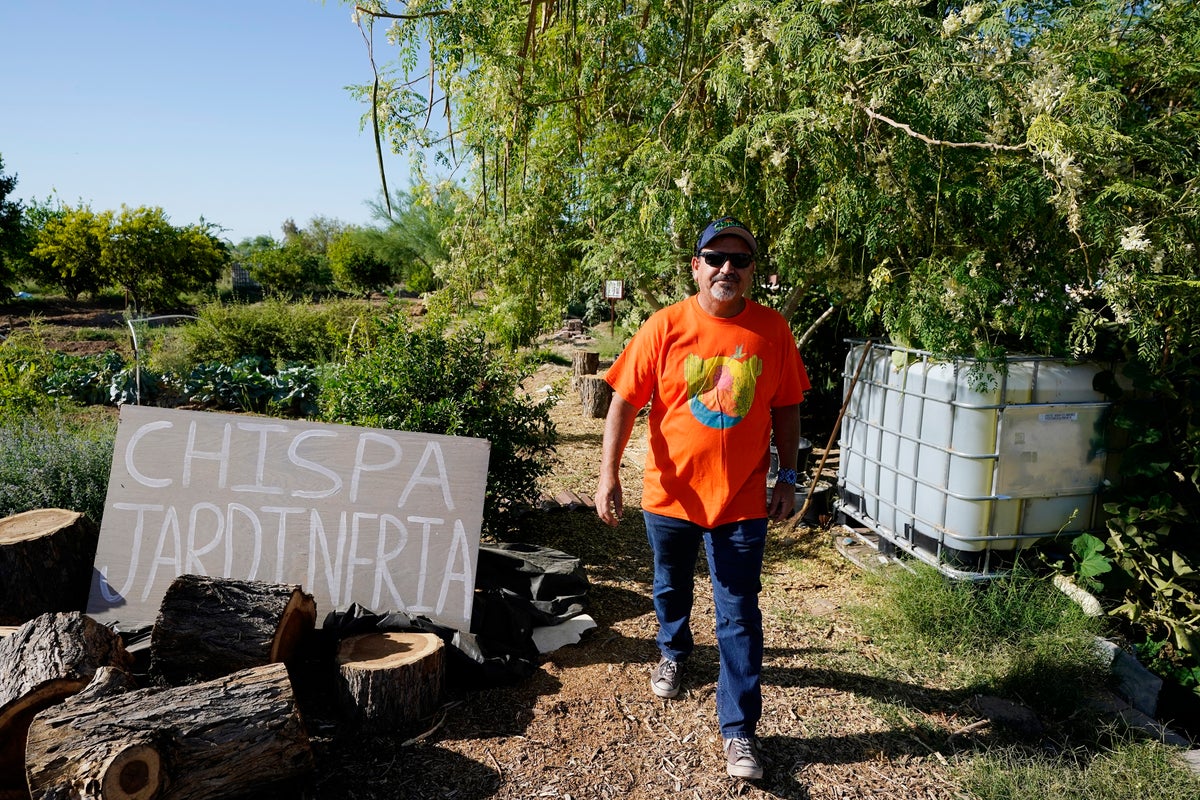
Students at a largely Hispanic elementary school in Phoenix have long lined up for morning classes on a dusty patch of dirt under a broiling sun.
So when Tony Mada learned of plans to plant 75 young trees at Borman Elementary School, the 30-year-old and his daughter Lilyth, 10, joined scores of volunteers to increase shade on campus.
Desert willows, oaks and mesquites just a few feet tall were among trees planted at the event organized by the local nonprofit Trees Matter and the environmental organization The Nature Conservancy, which is expanding its focus beyond the wildlands to urban areas impacted by climate-fueled heat.
“I’ll do anything to cool things down for my kids in this hot neighborhood,” Mada said one Saturday this spring as he and Lilyth, a student at the school, freed an acacia tree from the wooden box holding its roots.
After experiencing global warming's firsthand effects, U.S. Latinos are leading the way in activism around climate change, often drawing on traditions from their ancestral homelands.
“There has been a real national uprising in Latino activism in environmentalism in recent years,” said Juan Roberto Madrid, an environmental science and public health specialist based in Colorado for the national nonprofit GreenLatinos. “Climate change may be impacting everyone, but it is impacting Latinos more."
U.S. Latinos often live in ignored, lower income neighborhoods that are degrees hotter than nearby areas because they have a higher population density and limited tree canopy. Hispanics are also disproportionately affected by chronic health conditions aggravated by extreme heat, like diabetes and heart and kidney disease.
Latino activists are now sounding the alarm about the risks of global warming for their neighborhoods and the world. They include a teen who protested every Friday for weeks outside U.N. headquarters in New York, a Southern California academic who wants more grassroots efforts included in global climate organizing and a Mexico-born advocate in Phoenix who teaches young Hispanics the importance of protecting Earth for future generations.
“Many members of the Latinx community have Indigenous roots," said Masavi Perea, organizing director for Chispa Arizona, a program of the League of Conservation Voters. “A lot of us grew up on ranches, so many of us already have a relationship with nature.”
Walking through rows of kale, corn and squash at Chispa's plot in a south Phoenix garden, the 47-year-old said he works to increase the group’s base and educate young members about environmental issues like climate change.
Perea, a naturalized U.S. citizen originally from Mexico, said Chispa members include Central Americans he calls “climate refugees” who fled countries battered by hurricanes and droughts.
Recent research shows most Latinos in the U.S. consider climate change an important concern.
A Pew Research Center study released last fall showed about seven in 10 Latinos say climate change affects their communities at least some, while only 54% of non-Latinos said it affects their neighborhoods. The self-administered web survey of 13,749 respondents had a margin of error of plus or minus 1.4 percentage points.
Colorado College's Conservation in the West Poll published this year showed notably higher percentages of Latino, Black and Indigenous voters in eight western states concerned about climate change, pollution and the impact of fossil fuels.
Latino and other communities of color are disproportionately affected by climate change, such as more frequent, intense and longer heat waves in Phoenix, Las Vegas, Palm Springs and other arid western communities.
A study by researchers from the University of California, Davis and the American University of Beirut concluded last year that poor and Latino neighborhoods in 20 metro regions around the Southwest endure temperatures several degrees higher on the hottest days, creating greater risks for heat-related illness.
Phoenix, the hottest big city in the U.S., in recent years has seen some of its hottest summers, with a heat wave a year ago pushing temperatures up to 118 degrees (48 Celsius).
The city earlier this year worked with the conservation nonprofit American Forests to create the first of 100 “cool corridors” by planting shade trees for pedestrians and cyclists alongside a south Phoenix park named for the late Latino activist Cesar Chavez.
“It's much hotter here now than when I first moved here,” Democratic U.S. Rep. Ruben Gallego, who lives nearby, said as he toured the 259 newly planted drought resistant elm, ash, sissoo and Chinese pistache trees.
Gallego, who was born in Chicago and raised there by his Colombian mother, said segregation in Phoenix once forced Blacks and Latino residents to live in the city's south, which meant fewer trees and other investments there.
He has teamed up with fellow Democrat U.S. Rep. Bonnie Watson Coleman, of New Jersey, on a bill to create $30 million in federal grants annually for several years to ease the effects of urban heat, especially in low-income communities of color.
While many Latino activists focus their climate advocacy on their own neighborhoods, teenager Alexandria Villaseñor takes activism to the world stage.
Inspired by Swedish activist Greta Thunberg, Villaseñor spent many Fridays outside United Nations headquarters in New York in 2019, protesting global inaction on climate change.
Now 17, she is a co-founder of Earth Uprising, a climate change education group.
Climate policy scholar Michael Méndez, author of the book “Climate Change from the Streets,“ said grassroots organizing is equally important.
Méndez grew up the son of Mexican immigrants in Los Angeles County’s Fernando Valley, where he saw Latino neighbors fight against air pollution and dumping of toxic waste.
“It's not an abstract idea for us,” said Méndez, who teaches at the University of California, Irvine. "For Latinos, climate change is about how to protect our families, our children.”







